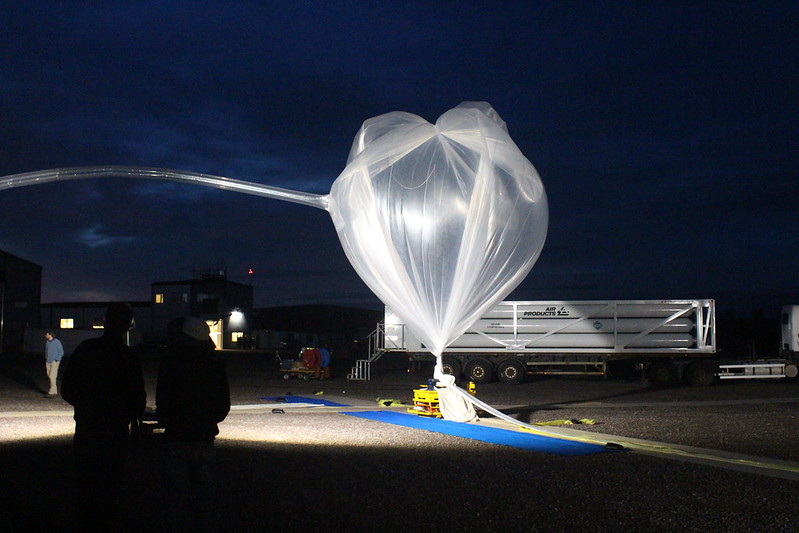What’s
a Solar Flare?
By
Anna Voelker
Solar flares are massive bursts of energy that
are characterized by brightening observed on the Sun. They are the
largest explosions in our solar system and can emit energy across the entire
electromagnetic spectrum!
This is an image of a flare occurring on the Sun, as viewed by the Solar Dynamics Observatory (SDO). SDO is a spacecraft that looks at the sun in a variety of wavelengths and temperatures to help scientists see and study different solar events. For example, this wavelength,131 angstroms, allows the brightening associated with flares to be extremely visible. Follow the link below to view a NASA video of this flare seen in multiple wavelengths:
http://svs.gsfc.nasa.gov/vis/a010000/a012200/a012224/APPLE_TV_12224_4.17.16.flare_appletv_subtitles.m4v
Solar flares are classified in units of X-ray
flux, which describes the amount of energy each flare emits over a given area.
A C-class flare has a flux value with a magnitude of 10e-6 W/m^2, M-class 10e-5
W/m^2, and X-class 10e-4 W/m^2. For comparison, the energy released by a flare
can be 10 million times greater than the energy released in a volcanic
explosion!
(See http://hesperia.gsfc.nasa.gov/sftheory/flare.htm for more details.)

Above is a graph that allows us to measure flare
intensity using data from the Geostationary Operational Environmental Satellite
(GOES) spacecraft. The vertical axis is X-ray flux and the horizontal axis is time (Universal
Time or greenwich mean time, the time zone used as the official
scientific time). Displayed in the top right-hand corner is the date, time, and
X-ray flux value corresponding to wherever one moves their cursor along the
graph. Shown here is the peak time and flux value of a flare that occurred on August 7. The maximum X-ray flux value of this flare was 1.37e-5 W/m^2, which we classify as an M1.3 flare.
This data can be accessed by going to iswa.gsfc.nasa.gov and selecting “GOES Primary X-ray flux Timeline” under the
eleventh tab in the magnetosphere section.
Flares are very important to monitor and
understand because they can cause radio blackouts and are associated with solar
energetic particles (SEPs), which can damage spacecraft electronics and pose a
threat to astronaut safety. Flares emit radiation that travels at the speed of
light and SEPs travel at relativistic speeds of up to 80% the speed of light. This means that by the time we see a flare the radiation is already here and particles may be well on their way. This is why flare forecasting (trying to predict flares before they occur to provide advanced notice) is an important and ongoing scientific pursuit.
Why
BARREL Cares
By
Alexa Halford
One of the very cool things about BARREL is that
with only one primary science experiment we can see and study events not just
in the Earth’s magnetosphere, but also on the Sun. When you have an explosive
event such as a flare on the Sun, X-rays are produced. Some of these X-rays are
scattered in all directions. As long as BARREL is in the line of sight, or in
other words, in sunlight, we can capture the X-rays and study various aspects
of the flare. Very few instruments have previously looked in the energy range
that we look at, and thus we can add to the science knowledge of this part of
the flare process.
We also care about documenting when BARREL is
seeing X-rays associated with a solar flare so that we don’t mistakenly try to
associate them with geomagnetic activity. One could say that the X-rays from
the flare are a contamination of our data since we’re most interested in X-rays
produced by radiation belt electrons in our atmosphere. I like to think of it
not as contamination but a wonderful surprise. With this we get to study yet
another field and do so much more research than we ever hoped for. Who would
have thought (and probably lots of people did) that this small little set of
balloons would be able to study not just the Earth’s radiation belt, not just
solar energetic particles, but also help us understand the flare process often
associated with the start of some of the larger space weather events! It’s just
so cool! One instrument, relatively cheap balloons, and so much science! Who
couldn’t love them!
Do you have any questions about flares? Want to
learn more about what other space phenomenon flares can cause or what causes a
flare in the first place? Feel free to ask your questions by commenting below!
Special thanks to Dustin Mayfield-Jones!










